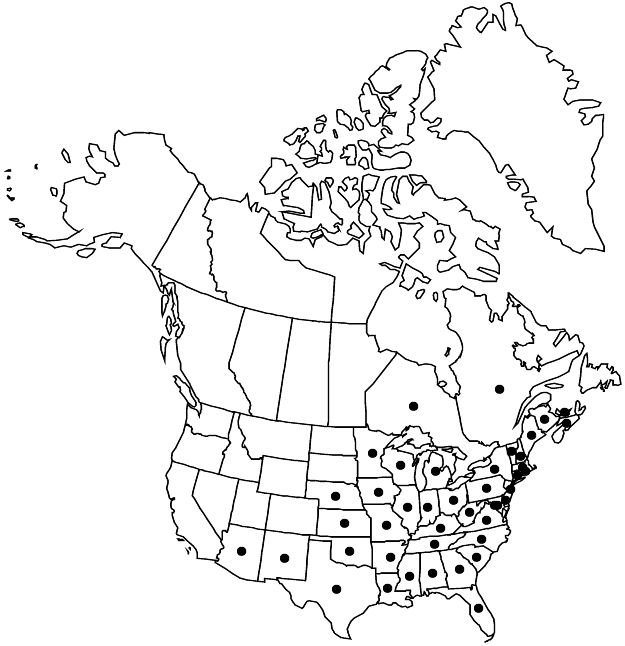Rubus flagellaris
Enum. Pl., 549. 1809.
Shrubs, to 3 dm, armed. Stems biennial, usually creeping, sometimes low-arching and then creeping flowering branches usually erect, glabrous or densely hairy, eglandular or sparsely sessile to short-stipitate-glandular, not pruinose; prickles sparse to dense, hooked, sometimes distally slender, 1–4 mm, broad-based; bristles absent. Leaves deciduous, some sometimes semipersistent, ternate or palmately compound, not lustrous; stipules filiform or linear to lanceolate, 3–20 mm; leaflets 3–5, terminal ovate or elliptic to suborbiculate, 3–11 × 2–7.5 cm, base broadly cuneate or rounded to shallowly cordate, usually unlobed, rarely shallowly lobed, margins moderately to coarsely serrate to doubly serrate or serrate-dentate, apex acute or acuminate to short-attenuate, abaxial surfaces with prickles on midvein or unarmed, sparsely to moderately hairy, eglandular or sessile or short-stipitate-glandular along largest veins. Inflorescences terminal on short-shoots, usually appearing axillary, 1–3 (–8) -flowered, racemiform. Pedicels unarmed or prickles sparse to moderate, retrorse to hooked, moderately to densely hairy, usually sparsely to densely sessile or short-stipitate-glandular, rarely eglandular. Flowers bisexual; petals white, elliptic, obovate, or oblanceolate, 8–20 mm; filaments filiform; ovaries glabrous. Fruits black, sometimes dark red, globose to cylindric, 1–2 cm; drupelets 10–40, strongly coherent, separating with torus attached. 2n = 14, 21, 28, 35, 42, 49, 56, 63.
Phenology: Flowering Mar–Jun.
Habitat: Woodlands, savannas, pine barrens, prairies, meadows, rock outcrops, disturbed areas, dry to seasonally wet soil
Elevation: 0–1000 m
Distribution

N.B., N.S., Ont., P.E.I., Que., Ala., Ariz., Ark., Conn., Del., D.C., Fla., Ga., Ill., Ind., Iowa, Kans., Ky., La., Maine, Md., Mass., Mich., Minn., Miss., Mo., Nebr., N.H., N.J., N.Mex., N.Y., N.C., Ohio, Okla., Pa., R.I., S.C., Tenn., Tex., Vt., Va., W.Va., Wis., Mexico (Coahuila), Mexico (Hidalgo), Mexico (Nuevo León), Mexico (San Luis Potosí), Mexico (Sonora)
Discussion
Rubus flagellaris is extremely polymorphic, ranging from plants with low-arching (and later creeping) stems and relatively few prickles to low, creeping plants with abundant prickles. Individual plants in some years will produce abundant, arching, poorly armed stems, and in others creeping, well-armed stems. Prickle shape also varies in these plants both within a year and among different years. Local variants seem to readily intergrade with other variants; over the entire North American range of what would be known as sect. Procumbentes (Rydberg) L. H. Bailey [= sect. Flagellares (L. H. Bailey) L. H. Bailey], a continuum of variation seems to be common. sect. Procumbentes (Rydberg) L. H. Bailey [by Bailey as sect. Flagellares (L. H. Bailey) L. H. Bailey
Apparent consistent features of Rubus flagellaris are terete primocanes to 7 mm diam. near the base and presence of rigid, hooked primocane prickles to 4 mm. Primocanes that tip-root and are low and long-running are nearly consistent features of R. flagellaris. Flower number per inflorescence throughout most of the geographic range of R. flagellaris is one to three or, rarely, five; in the far western part of the range (as R. arizonensis [= R. oligospermus Thornber ex Rydberg, name illegitimate]) up to eight flowers per inflorescence have been reported.
Rubus flagellaris lacks pruinose fruits and stems and is similar in general appearance to the introduced R. caesius.
Rubus vagus L. H. Bailey is an illegitimate later homonym that applies here. Rubus longipes Fernald is an illegitimate name that applies here.
The following nothospecies names are based on putative hybrids involving Rubus flagellaris and: R. allegheniensis (R. ×boyntonii Ashe, R. ×fraternalis L. H. Bailey [based on R. ×fraternus Brainerd & Peitersen (not R. fraternus Gremli)], R. ×licens L. H. Bailey; R. ×ostryifolius Rydberg); R. canadensis (R. ×lepagei L. H. Bailey, R. ×rixosus L. H. Bailey); R. hispidus (R. ×ambigens Fernald, R. ×distinctus L. H. Bailey, R. ×elongatus Brainerd & Peitersen [not R. elongatus Smith], R. ×emeritus L. H. Bailey, R. ×furtivus L. H. Bailey, R. ×kalamazoensis L. H. Bailey, R. ×permixtus Blanchard, R. ×rosendahlii L. H. Bailey, R. ×segnis L. H. Bailey, R. ×varus L. H. Bailey, R. ×vigoratus L. H. Bailey); R. pensilvanicus (R. ×akermanii Fernald, R. ×darlingtonii L. H. Bailey, R. ×dissitiflorus Fernald, R. ×hypolasius Fernald, R. ×janssonii L. H. Bailey, R. ×largus L. H. Bailey, R. ×recurvicaulis Blanchard, R. ×rossbergianus Blanchard); R. setosus (R. ×alter L. H. Bailey, R. ×arcuans Fernald & H. St. John, R. ×biformispinus Blanchard, R. ×bigelovianus L. H. Bailey, R. ×bracteolifer Fernald, R. ×jacens Blanchard var. specialis L. H. Bailey, R. ×laevior (L. H. Bailey) Fernald [based on R. permixtus var. laevior L. H. Bailey], R. ×multiformis Blanchard, R. ×setospinosus L. H. Bailey, R. ×severus Brainerd ex Fernald).
Selected References
None.
Lower Taxa
"thin" is not a number."dm" is not declared as a valid unit of measurement for this property.